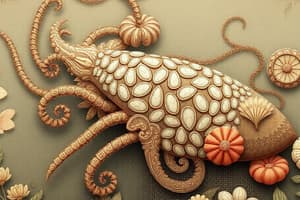Podcast
Questions and Answers
What is the main characteristic of a mollusk's body?
What is the main characteristic of a mollusk's body?
- Segmented body
- Hard, armored body
- Soft, unsegmented body (correct)
- Elongated, slender body
What is the function of a mollusk's radula?
What is the function of a mollusk's radula?
- To produce a shell
- To sense the environment
- To move around
- To scrape food (correct)
Which type of mollusk has a distinct head and tentacles?
Which type of mollusk has a distinct head and tentacles?
- Gastropods
- Bivalves
- Cephalopods (correct)
- Mantle
How do mollusks typically breathe?
How do mollusks typically breathe?
What is the importance of mollusks in ecosystems?
What is the importance of mollusks in ecosystems?
What is the type of circulatory system found in mollusks?
What is the type of circulatory system found in mollusks?
What is the characteristic of a mollusk's body structure?
What is the characteristic of a mollusk's body structure?
Which class of mollusk has a single shell?
Which class of mollusk has a single shell?
What is the main characteristic of a polyplacophora?
What is the main characteristic of a polyplacophora?
Which class of mollusk has a highly developed nervous system and senses?
Which class of mollusk has a highly developed nervous system and senses?
What is the main characteristic of a scaphopoda?
What is the main characteristic of a scaphopoda?
Which class of mollusk has the most diverse number of species?
Which class of mollusk has the most diverse number of species?
Flashcards are hidden until you start studying
Study Notes
Characteristics of Mollusks
- Soft, unsegmented body
- Often protected by a hard shell
- Bilateral symmetry
- Typically have a large, muscular foot used for movement and feeding
Body Structure
- Mantle: a layer of tissue that covers the body and secretes the shell
- Visceral mass: contains the internal organs
- Foot: used for movement, feeding, and sensing the environment
- Radula: a tooth-like structure used for feeding and scraping food
Types of Mollusks
- Gastropods: snails and slugs
- Typically have a single shell
- Often have a distinct head and foot
- Bivalves: clams, mussels, and oysters
- Have two hinged shells
- Often filter feeders
- Cephalopods: squid, octopuses, and nautiluses
- Have a distinct head and tentacles
- Often have a highly developed nervous system
Respiration and Circulation
- Respiration: often through gills or a mantle cavity
- Circulation: open circulatory system, with a heart that pumps blood-like fluid called hemolymph
Importance of Mollusks
- Ecological role: play a crucial role in many ecosystems as predators, prey, and decomposers
- Food source: many species are edible and are an important food source for humans and other animals
- Economic significance: pearls, shells, and other mollusk products are valuable commodities
Characteristics of Mollusks
- Mollusks have a soft, unsegmented body, often protected by a hard shell.
- They exhibit bilateral symmetry, meaning their body can be divided into two halves that are mirror images of each other.
- They have a large, muscular foot used for movement, feeding, and other functions.
Body Structure
- The mantle is a layer of tissue that covers the body and secretes the shell.
- The visceral mass contains the internal organs.
- The foot is a multi-purpose structure used for movement, feeding, and sensing the environment.
- The radula is a tooth-like structure used for feeding and scraping food.
Types of Mollusks
- Gastropods (snails and slugs) typically have a single shell, a distinct head, and a foot.
- Bivalves (clams, mussels, and oysters) have two hinged shells and are often filter feeders.
- Cephalopods ( squid, octopuses, and nautiluses) have a distinct head, tentacles, and a highly developed nervous system.
Respiration and Circulation
- Mollusks often breathe through gills or a mantle cavity.
- They have an open circulatory system, with a heart that pumps blood-like fluid called hemolymph.
Importance of Mollusks
- Mollusks play a crucial role in many ecosystems as predators, prey, and decomposers.
- Many species are edible and provide an important food source for humans and other animals.
- Mollusks have significant economic importance, with products like pearls, shells, and other commodities being highly valued.
Mollusk Classification
- Mollusks are classified into several groups based on body structure and characteristics.
Characteristics of Phylum Mollusca
- Soft, unsegmented body
- Often protected by a hard shell
- Bilateral symmetry
- Typically have a large mantle that secretes the shell
Classes of Mollusks
Monoplacophora
- Single-shelled mollusks
- Rare and ancient group
- Only a few living species
Polyplacophora
- Chitons, with eight shell plates
- Found in oceans worldwide
- Have a unique foot with radula for feeding
Gastropoda
- Snails and slugs
- Single shell or no shell
- Most diverse group of mollusks (over 60,000 species)
- Have a head with tentacles and a foot
Bivalvia
- Clams, mussels, oysters, and scallops
- Two hinged shells
- Filter feeders, using siphons to draw in water
- Often live in sediment or attached to surfaces
Cephalopoda
- Squids, octopuses, and nautiluses
- Highly developed nervous system and senses
- Active predators, often with complex behaviors
- Have a distinct head, arms, and a mantle
Scaphopoda
- Tusk shells, with a long, narrow shell
- Burrowing animals, often in sediment
- Feed on detritus and small organisms
Studying That Suits You
Use AI to generate personalized quizzes and flashcards to suit your learning preferences.




